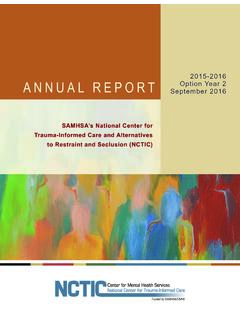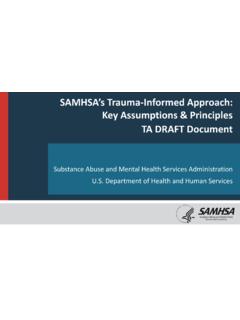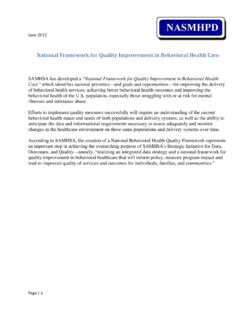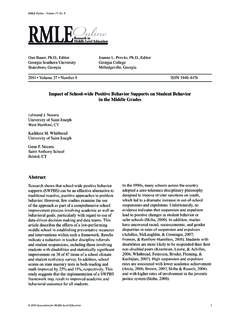Transcription of Changing Communities, Changing Lives - NASMHPD
1 Trauma-informed care is as much about social justice as it is about S NATIONAL CENTER FOR TRAUMA-INFORMED CAREC hanging communities , Changing LivesSeptember 2012 Behavioral Health is Essential to Health Prevention Works Treatment is Effective People RecoverSubmitted to:Mary BlakeSAMHSA Project Officer (COTR) for National Center for Trauma-Informed CarePublic Health AdvisorCommunity Support Programs BranchCenter for Mental Health ServicesSubstance Abuse and Mental HealthServices Administration Submitted by:Joan GilleceProject Director, SAMHSA s National Center for Trauma-Informed CareNational Association of State Mental Health Program DirectorsWritten by:Andrea BlanchConsultant, SAMHSA s National Center for Trauma-Informed CareNational Association of State Mental Health Program DirectorsCONTENTS:Trauma-Informed Services: A New Social Movement.
2 Page 2 3 NCTIC Activities ..Page 4 Survivor Empowerment ..Page 5 6 Supporting Organizational Change ..Page 7 Changing Systems, Changing Lives ..Page 8 9 Page 1 Susan Salasin, NCTIC founder and first SAMHSA project officerThe staff and consultants of the National Center on Trauma-Informed Care want to thank the thousands of trauma survivors and advocates across the country who dedicate their Lives to the work of trauma education and advocacy. With courage, wisdom, and passion, they are transforming the way the world responds to violence and trauma. Because of them, it is no longer acceptable for our public institutions to turn away from the interpersonal violence that destroys Lives and devastates communities .
3 They have broken down barrier after barrier, and they have shown all of us how to bear witness to trauma in our own Lives . We also thank the researchers and practitioners who developed and refined the concepts and the science on which this work is based. We are deeply grateful to the visionary leaders at SAMHSA who made the work of NCTIC possible, particularly Susan Salasin. Susan was one of the first to see the possibilities for social change inherent in the concept of trauma-informed care, and she created NCTIC to embody those possibilities. To all of you, we say courage, wisdom, and passion, they are transforming the way the world responds to violence and 2 Suddenly, it seems that everyone is talking about trauma.
4 In Kansas City and Philadelphia, Head Start and daycare providers are learning how trauma affects the behavior of young children. In Florida and connecticut , juvenile justice facilities are asking youth about their trauma histories and revamping their programs to address it. In Hawaii, the women s prison teaches inmates and staff about trauma and declares itself to be a place of healing and forgiveness. In Joplin, Missouri, the principles of trauma-informed care are being used to rebuild the town after it was destroyed by a tornado. Prominent journalists are writing columns about trauma, and courses on trauma-informed services are appearing on college campuses. Consumer/survivor/ex-patient communities have made trauma part of their social justice platform.
5 Trauma is no longer a concept of interest only to health and behavioral health professionals; it is a reality to people from all walks of life. In fact, trauma-informed care is beginning to look a lot like a social definition, social movements are loosely organized, collective, sustained efforts in support of a change in society s structure or values. They do not depend on a few leaders or organizations, but reflect a common vision shared by a growing alliance of individuals and groups. They may have vague goals and strategies, but they are sustained by the emerging hope that things could be current interest in trauma-informed approaches grew from a variety of sources, including the stories and voices of survivors; research on trauma and violence; the emergence of trauma treatment models; and social and political action to prevent and respond more effectively to violence.
6 Over time, we came to recognize how widespread trauma really is; how it impacts the developing brain; how it affects all aspects of a person s life and all parts of society. It became clear that we TRAUMA-INFORMED SERVICES: A NEW SOCIAL MOVEMENT Key Facts About TraumaTrauma occurs when external events overwhelm a person s coping responses. Trauma often has lasting adverse effects on physical, psychological, social and spiritual is widespread. The majority of people in human service and justice systems have trauma histories. Many have experienced multiple sources of service providers and first responders have also been impacted by can result from adverse childhood events, interpersonal violence, war, disaster, accidents, and other events or affects the brain by overloading the stress response system.
7 Symptoms are often adaptations to these neurological there are many common signs of trauma, every person reacts differently. Trauma often affects women and men differently, so gender-responsiveness is can affect every aspect of a person s life, including health, behavioral health, ability to learn, and can affect groups, organizations and communities as well as earlier in life trauma occurs, the more damaging the consequences are likely to are resilient and often recover from even severe trauma. With supports, healing is further information, Historical Roots of the Trauma- Informed Services Movement~ 1960s and 1970s ~Early research on survivors of captivity & warVietnam Vets form rap groups on war traumaFeminist and domestic violence movements ~ 1980s ~ PTSD diagnosis & treatment pioneered, VA establishes national center Mental health consumer/survivor/ex-patient movement gains momentum, calling for an end to restraint and seclusionVictims of Crime Act passed by CongressInternational Society for the Study of Traumatic Stress Disorders founded~ 1990s ~ First national trauma conference, Dare to Vision.
8 Highlights re-victimization and the voices of survivorsWomen, Co-Occurring Disorders & Violence Study funded by SAMHSAM ultiple models for trauma services developed Violence against Women Act passed by CongressAdverse Childhood Experiences study documents prevalence and impact of childhood trauma~ 2000s ~ SAMHSA establishes centers on child trauma, disasters, seclusion & restraint and trauma-informed careNeurological research documents pathways through which trauma impacts the brainSAMHSA declares trauma & justice a priority~ 2010s ~ Federal Partners Workgroup on trauma involves over 35 agencies and departmentsNational professional associations and media increase focus on traumaPage 3need effective and coordinated treatment and prevention strategies and an overall change in our helping systems.
9 The development of trauma-informed approaches gave people the tools they needed to begin this process. Maxine Harris and Roger Fallot first made the distinction between trauma-specific services (clinical treatments) and the culture change referred to as trauma-informed care. 1 Trauma-informed care is a powerful framework because it provides hope that there is a better way to handle some of our most pressing social problems. And it is potentially unifying because it can be applied in any setting. The basic premise is that everyone can benefit from learning about trauma. Staff learn new ways to interact with the people they serve, and everyday citizens respond differently when they encounter the results of trauma.
10 NCTIC was launched by SAMHSA in 2005 and is now managed by the National Association of State Mental Health Program Directors ( NASMHPD ), one of the earliest national organizations to recognize the importance of trauma. Working in partnership with growing numbers of trauma survivors and organizations across the country, NCTIC has been a major force in helping this new movement take Harris, M. and Fallot, R. (Eds.) (2001) Using Trauma Theory to Design Service Systems. New Directions for Mental Health Services, 89, 4 NCTIC ACTIVITIES NCTIC s impact is truly national in scope. Since 2005, NCTIC consultants have worked on-site in 45 states and territories and one Canadian province, and have collaborated with representatives from eight additional states and territories.














